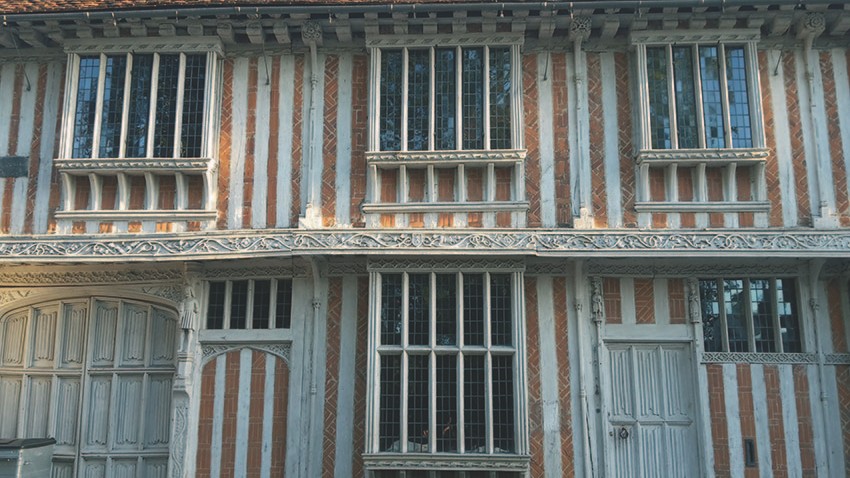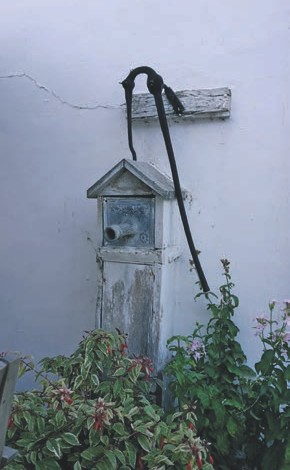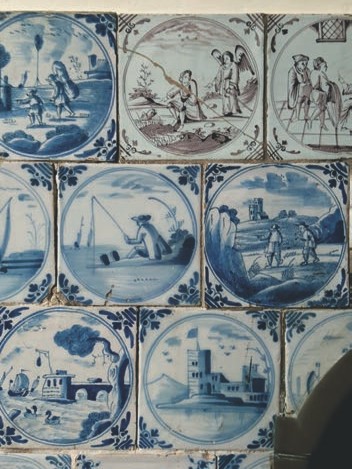Paycocke’s House: a witness to history

The small town of Coggeshall flows between River Blackwater and the A120. It is almost unbelievably picturesque. Approaching from the west, along the A120, when fog fills the Blackwater valley, there is something of an air of Brigadoon about the place, as ancient building after ancient building emerges from the mist, timbers and pargeting proliferating.
It is a village of rare distinction, which can also boast not only one, but two architecturally significant National Trust properties. Grange Barn looks over the town from the hill above the River. It was built as the tithe barn for the nearby Coggeshall Abbey – the cathedral like scale of the Barn is a very physical demonstration of the fabulous wealth of the Cistercian foundation, with its connections across Europe. The abbots were the main seat of power in Coggeshall; they also owned the market place and the chapel there. One of the massive timbers which support the roof, with its 75000 tiles, is some 1000 years old. The structure of the building dates it to around 1140 although it underwent a major rebuilding just before the Peasants’ Revolt, around 1380. The use of the building seems to have evolved; from acting as the storage for the Great Tithes to a more active role in the processing of wheat. The whole building was shortened and the central door in the southern side was replaced by two very large doors with porches. These large doors gave enough space for carts laden with the produce from the fertile fields around Coggeshall. Two corresponding smaller doors in the northern side not only allowed the empty carts to leave, but created the through-draught needed to thresh the corn.
The Great Barn has weathered changes in religion, changes in society and changes in agricultural practice, until they changed beyond all recognition for the original medieval monks who laboured there. By the late 1970s, the Barn was a near ruin and a dedicated team of shipwrights and carpenters set about the Herculean task of restoring it to its former glory.
Grange Barn was already 400 years old when, in 1509, Thomas Paycocke added a new, richly carved and luxurious front wing to the house he inherited from his father. Thomas Paycocke is most easily described as a wool merchant, although the fine details are a lot more complex. He was at the very forefront of a revolution in the production of goods – a very, very early harbinger of the industrial revolution to come. Before Paycocke and his near contemporary Thomas Spring of Lavenham, wool made the journey from the back of a sheep to the back of a man (labourer or king) in a very linear process, with each stage being carried out by separate individuals working in their own premises.
The revolution of the late 15th and early 16th centuries was for one individual to bring all these processes together and to provide both materials and wages for all the myriad stages. This was a dramatic change from the self-supporting artisan to a wage earning employee, and it made Thomas Paycocke incredibly wealthy. The merchant was exploiting the economic conditions of the time. Raw wool and grain prices had fallen in the 1490s, and remained low until they began to rise together from about 1512. At the same time there was a boom in cloth exports. Just a year before Thomas Paycocke built the new front of Paycocke’s House, some 93,000 clothes were exported; the highest number then recorded.
Thomas Paycocke was far from a self-made man. His father John Paycocke had left him, the younger son, “my house lying and bielded in the Weststrete of Coggeshall abovesaid afore the vicarage ther” on his death in 1506. The house was just one of many properties owned by John Paycocke who was described as a “butcher;” surely a term that from his land and property holding must connote more than the mere slaughtering and selling of meat. John Paycocke’s father, another Thomas, and another “butcher,” was the local collector of lay subsidies in the
mid-15th Century and also owned some land in Earls Colne. It seems that both of these older Paycockes were involved in wholesale meat production, taking advantage of cheap land prices to act as graziers and distributors. A necessary by-product of the meat industry would have been wool and it seems only natural that the family business migrated to take advantage of the economic climate.
Despite his land holdings, John Paycocke’s will was relatively modest in comparison with that of his son Thomas a mere 12 years later. The elder Paycocke’s largest cash bequest was 10 marks to his unmarried daughter Alice. Thomas Paycocke, on the other hand, left 500 marks to his widow, 500 marks for his unborn child and 500 marks to the local church. This is not including a whole host of much smaller bequests to family, friends and employees. Paycocke’s will is a testament to the relationships with his employees even if the number of people he is employing is shrouded. For example John Beycham “my weyver” was left a gown and doublet as well as £5. Gifts of cloth in wills were a sign of high favour. Another named beneficiary, Robert Taylor (who was in fact a fuller), received 3s 4d, while Thomas “forgives all that is betwixt us.” A mark was worth two- thirds of a pound, and a very rough totalling of all the bequests (with a certain amount of estimating) brings the total to around
£1500 in cash bequests, not including goods or property. This is equivalent to roughly £570,000 in today’s money.
Like so many similar documents of the time, Paycocke’s last will and testament is the only glimpse that we get into the man’s motivations, emotional links and dependencies, even his confidence in himself and his social position.
As a nation we retain a fascination for the Tudor era; it is the very earliest days of the modern era, with a geopolitical world that we can recognise but with the added glamour of intermingling brocade and squalor; lived experiences that were both more handmade and more luxurious than our own. Looking backwards, the Tudor age seems newly minted, a time of revolution, progress and revulsion. It appeals to the grotesque and the Utopian.

Paycocke’s House dates from the early years of the Tudors, those slightly less exciting times before Shakespeare, before Thomas Cromwell, and when there was only one wife. The front wing of the house was built in 1509, the same year as Henry VIII ascended the throne, and the same year that he married Catherine of Aragon, his late elder brother’s widow. One of the most interesting, and indicative of Thomas Paycocke’s bequests, is the 500 marks for a chantry in St Catherine’s Chapel of St Peter ad Vincula in Coggeshall. The bequest was to pay for prayers for himself, his wife, his father and mother, his late father-in-law and for all his friends’ souls. It also paid for six poor men to say masses six times a week and a priest to sing before St Catherine’s altar, in the same chapel where Thomas himself, his father and grandfather were buried. The masses were to ease all these souls through purgatory and onto heaven.
It is a bequest deeply rooted in the high medieval Catholic tradition that dominated every aspect of daily life in a way that we moderns can only dimly comprehend. Was Thomas Paycocke aware of the seismic doctrinal shift happening in Germany as he was writing his will? Only a year before the monk Martin Luther had posted his Ninety-Five Theses on 31st October 1517, condemning the practice of indulgences – the selling of certificates, frequently by travelling salesmen, loosely described as preachers, which guaranteed fast progression through purgatory. It was the medieval, ecclesiastical equivalent of the Monopoly get out of jail card – although it was far from free. Indulgence sellers roamed England as well as Germany and may indeed have passed past the front door of Paycockes. The money raised went on a long journey back to Rome where whatever the devotional origins of the money, it was being used to completely rebuild and decorate the Vatican. As Thomas Paycocke inspected the carving of the bressumer on the new front of his house, Pope Julius II was inspecting Michelangelo’s work on the Sistine Chapel, a year in to the four year project. Martin Luther’s Theses were just the most visible expression of the rumbling tide of discontent that would become the Reformation.
Poorly taught and poorly understood in the UK, this Europe-wide rage-filled calls to end rampant church corruption, money- making and flagrant abuses of power through a return to the relatively unembellished teaching of the Gospels; available to all, translated and printed in the vernacular, had only the most tenuous links to Henry VIII’s love life. The doctrine of purgatory and the practice of singing masses for the dead were just some of the many established practices that would be overturned by the Protestant reformers. If Thomas Paycocke has made his will a mere 15 years later, his bequests would have been strikingly different.
The house has watched over religious and social change and remained remarkably unaffected. Economic and technological change however has reshaped its roofline, moved doorways and staircases, raised and razed entire wings.

Like much of East Anglia, and southern England more broadly, Paycockes and Coggeshall were built on wool. Throughout the 13th and 14th centuries, the country’s major and most profitable export had been raw wool. When the continent caught up and exceeded English production, exports turned to woollen cloth. Major towns and areas of production were controlled by the powerful Guilds, stifling competition and innovation. Smaller centres away from Guild dominance sprang up and thrived. Coggeshall is just one of many examples in Essex and Suffolk. Easy access to London and the continent as well as overland trade routes supplying raw wool created opportunities and wealth.
Then the world got larger and smaller – ships sailed across the world, houses changed, and fashion was cut from a different cloth. After Thomas’s death (and in accordance with his will), the house and business by-passed his then unborn daughter and was inherited by his nephew. By the end of the sixteenth century the Paycocke’s line had died out in Coggeshall with the house passing by marriage to the Buxton family, who were also Essex clothiers.
By the Victorian period it had fallen on hard times. There was a brewery in what is now the back garden and the house was divided into three tenements. In 1891 it was saved from destruction by Charles Pudney, a haulier, who repaired it, using it as a store house and business premises. He sold it in 1904 for
£500 to Noel Buxton who later became one of the first Labour peers. He was also a descendant of the Buxton family who had owned the house in previous centuries. Working with a local carpenter, Ernest Beckworth, who had walked past the house all his life, and fallen in love with it, he embarked on an aggressive restoration of the house to show how he thought it might have looked in the past. The house we see today is very much the results of this vision, with the house that Thomas Paycocke might have known peeping through around the edges.
During the restoration, Buxton’s cousin, Conrad Noel, lived in the building with his wife Miriam, better known perhaps as the “Red Vicar of Thaxted,” In 1911, around the time that he was living at Paycocke’s, he became a founding member of the British Socialist Party and both left-wing cousins were clearly followers of fellow Socialist William Morris’s Arts & Crafts movement, evidenced not just in the house, but also in the charming garden put together by Miriam Noel. There is a certain irony in the fact that the house, built by one of the country’s first true capitalists, was saved by such passionate socialists.

The house was described by architectural historian Nicholas Pevsner as “one of the most attractive half-timbered houses in England”, and it had long been on the acquisitions list for the growing National Trust. In 1924 Noel gave it to the Trust, and for long decades it was let out to a series of more and less devoted tenants who agreed to open the house occasionally throughout the year for the visitors who came on pilgrimage to see this architectural glory. The last tenant left a mere 8 years ago, with more and more rooms being open to visit every year. It’s relative “newness” as a National Trust property gives it a freshness and a freedom that belies the great age of the house. The great gulfs in what we know of its history, the shadowy years and the great sweep of British and European history that runs in the background, make it endlessly fascinating; a place that can be rediscovered and reinterpreted by every visitor. Opening and displaying a house as historic Paycockes is an ongoing process and a labour of love. Today, over 70 volunteers play vital roles in opening the House and the Barn, restoring and maintaining the gardens and ensuring that the thousands of visitors have the warmest of welcomes. Everyone who crosses the threshold is not only discovering history, they are shaping it, as their experiences and thoughts become part of the story of this fascinating place.
Lizzie Dunford
House Manager, Coggeshall Properties National Trust
Paycocke’s House will be open 7 days a week from Saturday 18th March until Sunday 29th October, 11.00am to 5.00pm (last entry 4.30pm)
Grange Barn will be open Wednesday to Sunday from Saturday 18th March until Sunday 29th October, 11.00am to 4.00pm There are voluntary opportunities in a range of roles at both properties. Please contact paycockes@nationaltrust.org.uk for more details.
Lizzie Dunford graduated from the University of Lincoln with a MA in Conservation of Historic Objects and has worked for the National Trust since 2010. She has previously worked as Senior Visitor Experience Officer at Dunstable Downs, and was House Steward at Shaw’s Corner for five years, where she researched and published on the collection and its connections with the life and work of playwright George Bernard Shaw. Lizzie came to Coggeshall as House Manager in September 2016, joining an established and dedicated team of volunteers.

